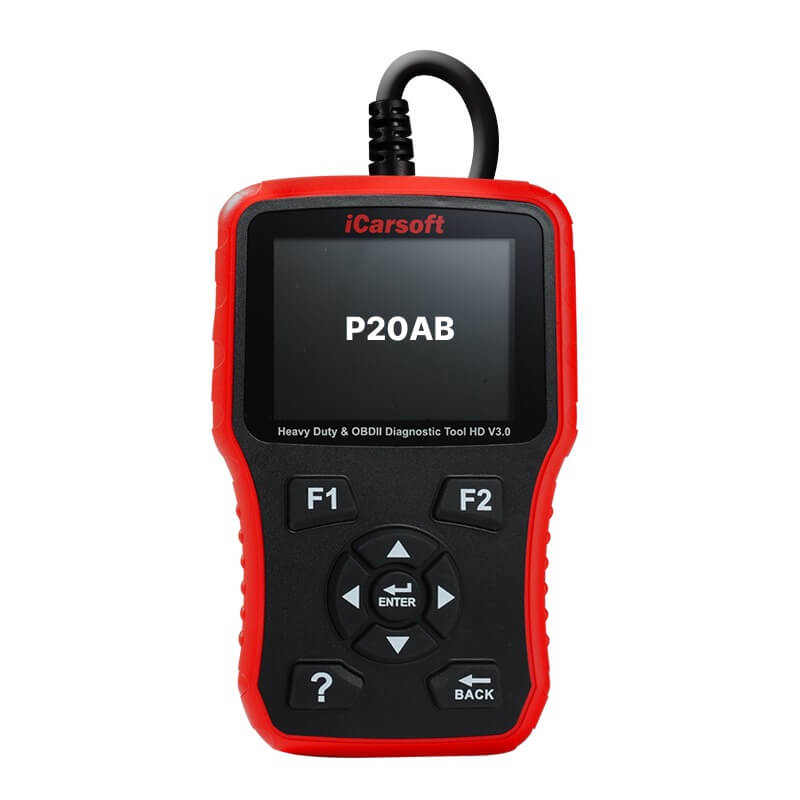P20AB – Reductant Tank Temperature Sensor Circuit Range / Performance
POSTED IN pcodes
Welcome to our article on the P20AB code, which relates to the reductant tank temperature sensor circuit range and performance. In this section, we will provide you with a technical description of this code, its meaning and severity, common symptoms, as well as the potential causes and troubleshooting steps for repair. So, let’s dive in and learn more about the P20AB code and its implications for your vehicle.
Key Takeaways:
- The P20AB code indicates an issue with the control circuit of the reductant tank temperature sensor.
- Common symptoms of this code include an illuminated check engine light, no DPF regeneration, and reduced power mode.
- Possible causes of the P20AB code include a faulty reductant heater, a bad temperature sensor, wiring issues, or a malfunctioning glow plug control module or SCR controller.
- Proper diagnosis involves inspecting the harnesses and connectors, testing power supply and output control circuit voltage, and consulting a repair manual for specific troubleshooting steps.
- Addressing the P20AB code promptly is crucial to prevent further damage to the emission reduction system and potential catalytic converter damage.
What is a Reductant Tank Temperature Sensor and Why is it Important?
The reductant tank temperature sensor is a crucial component in modern vehicle emission reduction systems. It plays a critical role in maintaining the optimal temperature of the reductant, also known as diesel exhaust fluid (DEF), stored in the vehicle’s reductant tank. By measuring and monitoring the temperature of the reductant, this sensor ensures that the DEF remains within the desired temperature range for the selective catalytic reduction (SCR) system to function effectively.
The SCR system relies on the injection of DEF into the exhaust stream to reduce harmful NOx (nitrogen oxides) emissions, converting them into harmless nitrogen and water vapor. The reductant tank temperature sensor helps regulate the DEF’s temperature, preventing freezing or crystallization in colder climates and maintaining its fluid state for proper injection into the exhaust system.
The importance of the reductant tank temperature sensor lies in its role in optimizing the SCR system’s performance and meeting stringent emission standards. Without accurate temperature monitoring, the DEF’s effectiveness in reducing emissions may be compromised, leading to increased air pollution and potential non-compliance with environmental regulations.
Additionally, the reductant tank temperature sensor indirectly affects the overall efficiency and longevity of the vehicle’s emission control system. By ensuring that the DEF is at the correct temperature, the sensor helps prevent damage to other SCR components, such as the catalyst and injector, which could occur due to DEF freezing or overheating.
Buy tested tuning file for Adblue / EGR / DPF / Adblue off now!
“The reductant tank temperature sensor is a vital component in maintaining the optimal temperature of the reductant, ensuring efficient emission reduction in the SCR system.”
Overall, the reductant tank temperature sensor is an essential part of modern emission control systems, contributing to the vehicle’s compliance with environmental regulations and reducing its impact on air quality. By maintaining the proper temperature of the DEF, this sensor helps ensure the effective operation of the SCR system and the reduction of harmful emissions.

| Brand | Model | Temperature Range | Compatibility |
|---|---|---|---|
| Brand A | Sensor X | -40°C to 120°C | Compatible with SCR systems of major vehicle manufacturers |
| Brand B | Sensor Y | -50°C to 150°C | Universal compatibility |
| Brand C | Sensor Z | -30°C to 100°C | Designed for specific vehicle makes and models |
What Does the P20AB Code Mean?
The P20AB code signifies a potential issue with the control circuit of the reductant tank temperature sensor. Specifically, it indicates that the voltage signal from the control circuit of the sensor is outside the expected range. This code may also be stored if the reductant heater does not perform as required. It is important to consult a specific repair manual or database to determine which is the designated circuit for the reductant heater in your vehicle.
Symptoms and Severity of the P20AB Code
The P20AB code can manifest through various symptoms that indicate a potential issue with the vehicle’s emission reduction system. It is crucial to be aware of these symptoms and address them promptly to avoid further complications. The severity of the P20AB code is considered high due to the potential disabling of the selective catalytic reduction (SCR) system and the risk of catalytic converter damage if left unattended.
Common Symptoms of the P20AB Code
- An illuminated check engine light is a common indication that the P20AB code is present. The vehicle’s onboard diagnostic system detects a fault in the reductant tank temperature sensor circuit and triggers the check engine light to alert the driver.
- The inability to perform a diesel particulate filter (DPF) regeneration is another symptom associated with the P20AB code. The reductant tank temperature sensor plays a crucial role in the regeneration process by ensuring the optimal temperature for efficient emission reduction. When this sensor malfunctions, the DPF regeneration process may not occur correctly.
- When the P20AB code is present, the vehicle may enter reduced power mode. This mode limits the engine’s performance to protect the emission system. It is implemented as a precautionary measure when a fault in the reductant tank temperature sensor circuit is detected.
It’s essential to note that these symptoms may vary depending on the make and model of the vehicle. Consulting a professional mechanic or referring to a vehicle-specific repair manual can provide accurate diagnostic information.
Severity of the P20AB Code
The severity of the P20AB code is considered high due to its potential impact on the vehicle’s emission reduction system. If left unaddressed, the code can disable the SCR system, which is responsible for reducing harmful emissions. Moreover, prolonged exposure to the faulty reductant tank temperature sensor circuit can lead to catalytic converter damage.
Considering the potential consequences, it is crucial to diagnose and fix the P20AB code promptly to ensure the proper functioning of the emission system and reduce pollution.
Diagnosing and Fixing the P20AB Code
Proper diagnosis of the P20AB code requires narrowing down the main cause from a list of possible causes. This involves a thorough inspection of the reductant heater system harnesses and connectors to look for any damage or issues. The use of a diagnostic scanner and a digital volt/ohmmeter (DVOM) is essential for testing the power supply, ground circuits, and output control circuit voltage of the reductant heater. If necessary, consulting a vehicle-specific repair manual or database can provide detailed troubleshooting steps and component testing procedures for a specific make and model.
Conclusion
The P20AB code indicates a potential issue with the control circuit of the reductant tank temperature sensor. Promptly addressing this code is crucial to prevent further damage to the emission reduction system and potential catalytic converter damage. Professional assistance is highly recommended for proper diagnosis and repair. However, in cases where professional help is unavailable or costly, an alternative solution could be the permanent removal of the P20AB code by uploading the Engine Control Unit (ECU) file to a designated portal.
Taking action to diagnose and fix the P20AB code is vital in ensuring the proper functioning of the selective catalytic reduction (SCR) system and reducing harmful emissions. Ignoring or delaying repairs can lead to more severe issues and potentially higher repair costs in the long run. It is recommended to consult a vehicle-specific repair manual or database for detailed troubleshooting steps and component testing procedures, as different makes and models may vary in their diagnostic process.
By addressing the P20AB code promptly, you can safeguard your vehicle’s emission reduction system and help contribute to a cleaner environment. Remember, maintaining and repairing your vehicle’s onboard diagnostics is a responsible step towards minimizing your vehicle’s impact on air pollution. Regular maintenance and addressing diagnostic trouble codes like the P20AB code are essential for ensuring optimal performance and durability of your vehicle’s emissions control system.
FAQ
What is the P20AB code for?
The P20AB code refers to the reductant tank temperature sensor circuit range/performance. It indicates a potential issue with the control circuit of the reductant tank temperature sensor.
What are the symptoms of the P20AB code?
The common symptoms of the P20AB code include an illuminated check engine light, no diesel particulate filter (DPF) regeneration, and the vehicle entering reduced power mode.
What are the possible causes of the P20AB code?
The possible causes of the P20AB code include a faulty reductant heater, a bad reductant temperature sensor, wiring issues such as open or shorted circuits, and a malfunctioning glow plug control module or SCR controller.
How severe is the P20AB code?
The severity of the P20AB code is considered high as it may disable the selective catalytic reduction (SCR) system and potentially cause catalytic converter damage if not addressed urgently.
How do I diagnose and fix the P20AB code?
Proper diagnosis of the P20AB code requires a thorough inspection of the reductant heater system harnesses and connectors, as well as testing the power supply, ground circuits, and output control circuit voltage of the reductant heater using a diagnostic scanner and a digital volt/ohmmeter (DVOM). Consulting a vehicle-specific repair manual or database can provide detailed troubleshooting steps and component testing procedures.
What is the importance of a reductant tank temperature sensor?
The reductant tank temperature sensor measures the temperature of the reductant (diesel exhaust fluid) in the tank. It helps regulate the temperature of the reductant to prevent freezing or crystallizing in low temperatures, ensuring efficient emission reduction in the selective catalytic reduction (SCR) system.
What does the P20AB code mean?
The P20AB code indicates a potential issue with the control circuit of the reductant tank temperature sensor. It signals that the voltage signal from the control circuit is outside the expected range or that the reductant heater is not performing as required.
How do I diagnose and fix the P20AB code?
Diagnosing and fixing the P20AB code involves inspecting the reductant heater system for damage or issues, testing the power supply, ground circuits, and output control circuit voltage of the reductant heater using a diagnostic scanner and a digital volt/ohmmeter (DVOM). Consulting a vehicle-specific repair manual or database can provide detailed troubleshooting steps and component testing procedures.
Can I remove the P20AB code permanently?
While professional assistance is recommended, a potential alternative solution is uploading the Engine Control Unit (ECU) file to a designated portal to permanently remove the P20AB code. However, it is important to address the underlying issue to ensure proper functioning of the selective catalytic reduction (SCR) system and reduce harmful emissions.


